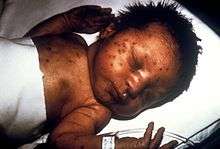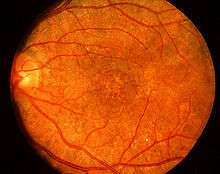Congenital rubella syndrome
| Congenital rubella syndrome | |
|---|---|
_PHIL_4284_lores.jpg) White pupils due to congenital cataract in a child with congenital rubella syndrome | |
| Classification and external resources | |
| Specialty | Teratology |
| ICD-10 | P35.0 |
| ICD-9-CM | 771.0 |
| DiseasesDB | 11729 |
| MedlinePlus | 001658 |
| eMedicine | emerg/388 |
| MeSH | D012410 |
Congenital rubella syndrome (CRS) can occur in a developing fetus of a pregnant woman who has contracted rubella, usually in the first trimester. If infection occurs 0–28 days before conception, the infant has a 43% chance of being affected. If the infection occurs 0–12 weeks after conception, the chance increases to 51%. If the infection occurs 13–26 weeks after conception, the chance is 23% of the infant being affected by the disease. Infants are not generally affected if rubella is contracted during the third trimester, or 26–40 weeks after conception. Problems rarely occur when rubella is contracted by the mother after 20 weeks of gestation and continues to disseminate the virus after birth.
It was discovered in 1941 by Australian Norman McAlister Gregg.[1]
The molecular basis for the causation of congenital rubella syndrome are not yet completely clear, but in vitro studies with cell lines showed that rubella virus has an apoptotic effect on certain cell types. There is evidence for a p53-dependent mechanism.[2]
Signs and symptom



The classic triad for congenital rubella syndrome is:[4]
- Sensorineural deafness (58% of patients)
- Eye abnormalities—especially retinopathy, cataract, and microphthalmia (43% of patients)
- Congenital heart disease—especially pulmonary artery stenosis and patent ductus arteriosus (50% of patients)[5]
Other manifestations of CRS may include:
- Spleen, liver, or bone marrow problems (some of which may disappear shortly after birth)
- Intellectual disability
- Small head size (microcephaly)
- Eye defects
- Low birth weight
- Thrombocytopenic purpura
- Extramedullary hematopoiesis (presents as a characteristic blueberry muffin rash)
- Hepatomegaly
- Micrognathia
Children who have been exposed to rubella in the womb should also be watched closely as they age for any indication of:
- Developmental delay
- Autism[6]
- Schizophrenia[7]
- Growth retardation[8]
- Learning disabilities
- Diabetes mellitus[9]
- Glaucoma
Prevention
Vaccinating the majority of the population is effective at preventing congenital rubella syndrome.[10]
References
- ↑ Atkinson, William (2011). Epidemiology and Prevention of Vaccine-Preventable Diseases (12 ed.). Public Health Foundation. pp. 301–323. ISBN 9780983263135. Retrieved Mar 2015.
- ↑ Megyeri K, Berencsi K, Halazonetis TD, et al. (June 1999). "Involvement of a p53-dependent pathway in rubella virus-induced apoptosis". Virology 259 (1): 74–84. doi:10.1006/viro.1999.9757. PMID 10364491.
- ↑ Sudharshan S, Ganesh SK, Biswas J (2010). "Current approach in the diagnosis and management of posterior uveitis". Indian J Ophthalmol 58 (1): 29–43. doi:10.4103/0301-4738.58470. ISSN 0301-4738. PMC 2841371. PMID 20029144.
- ↑ "Congenital rubella syndrome | Sense". www.sense.org.uk. Retrieved 2015-07-30.
- ↑ Oster ME, Riehle-Colarusso T, Correa A (January 2010). "An update on cardiovascular malformations in congenital rubella syndrome.". Clin Mol Teratol. 88 (1): 1–8. doi:10.1002/bdra.20621. PMID 19697432.
- ↑ Muhle, R; Trentacoste, SV; Rapin, I (May 2004). "The genetics of autism.". Pediatrics 113 (5): e472–86. doi:10.1542/peds.113.5.e472. PMID 15121991.
- ↑ Brown, A. S (9 February 2006). "Prenatal Infection as a Risk Factor for Schizophrenia". Schizophrenia Bulletin 32 (2): 200–202. doi:10.1093/schbul/sbj052. PMC 2632220. PMID 16469941.
- ↑ "Pathogenesis of congenital rubella". JAMA 194 (12): 1277–1283. 1965-12-20. doi:10.1001/jama.1965.03090250011002. ISSN 0098-7484.
- ↑ Forrest, JillM.; Menser, MargaretA.; Burgess, J. A. (1971-08-14). "HIGH FREQUENCY OF DIABETES MELLITUS IN YOUNG ADULTS WITH CONGENITAL RUBELLA". The Lancet. Originally published as Volume 2, Issue 7720 298 (7720): 332–334. doi:10.1016/S0140-6736(71)90057-2.
- ↑ "Rubella vaccines: WHO position paper." (PDF). Wkly Epidemiol Rec 86 (29): 301–16. 15 July 2011. PMID 21766537.
External links
| ||||||||||||||||||||||||||||||||||||||||||||||||||||||||||||||||||||||||||||||||
| ||||||||||||||||||||||||||||||||||||||||||||||||||||||||||||||
| ||||||||||||||||||